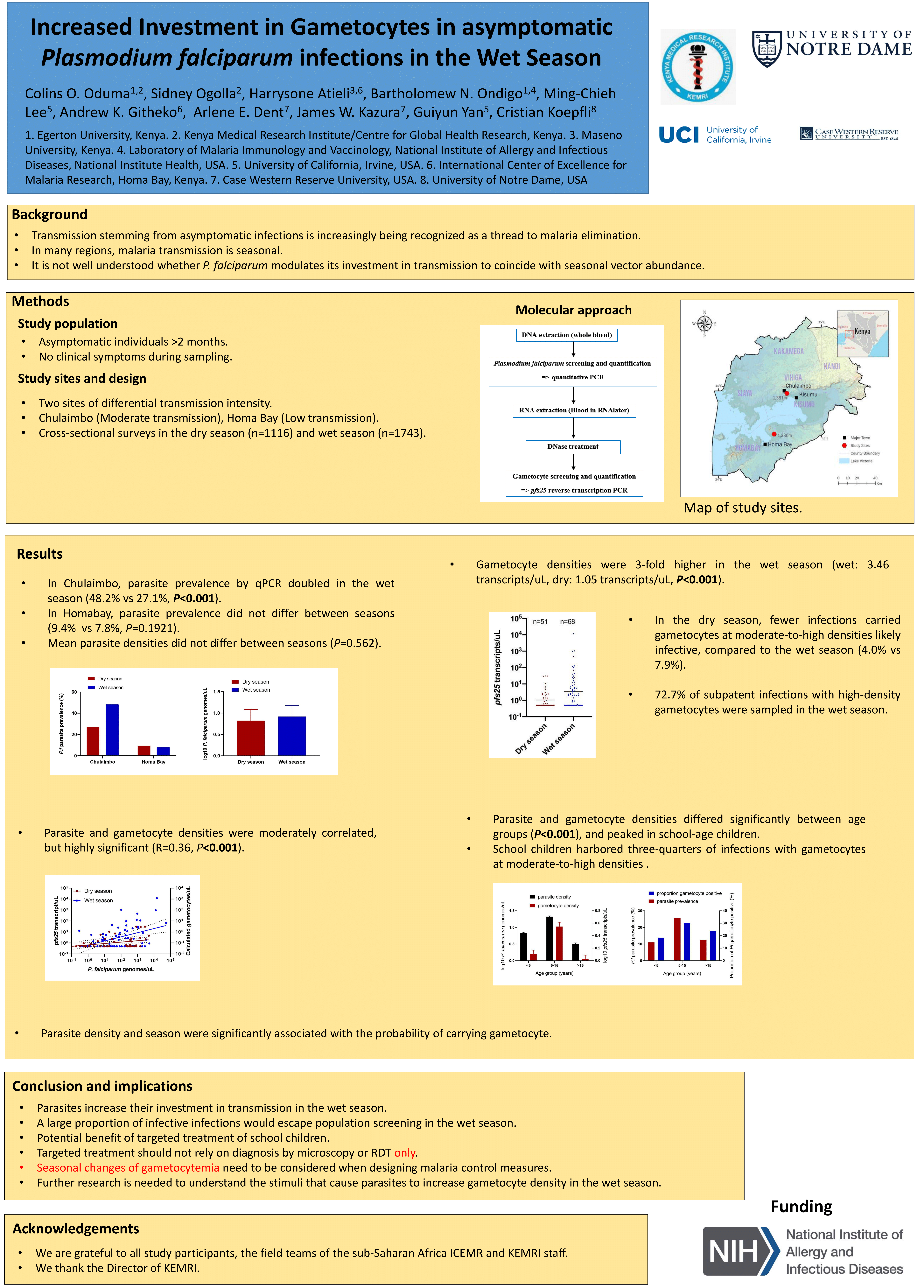Conference 2021 Poster Presentation
Project title
Increased Investment in Gametocytes in asymptomatic Plasmodium falciparum infections in the Wet Season
Authors and Affiliations
Colins O. Oduma1,2, Sidney Ogolla2, Harrysone Atieli3,6, Bartholomew N. Ondigo1,4, Ming-Chieh Lee5, Andrew K. Githeko6, Arlene E. Dent7, James W. Kazura7, Guiyun Yan5, Cristian Koepfli8
1. Department of Biochemistry and Molecular Biology, Egerton University, Nakuru, P.O Box 536 – 20115, Kenya
2. Kenya Medical Research Institute/Centre for Global Health Research, Kisumu, P.O Box 1578 – 40100, Kenya
3. School of Public Health, Maseno University, Maseno, P.O Box 3275 – 40100, Kenya
4. Laboratory of Malaria Immunology and Vaccinology, National Institute of Allergy and Infectious Diseases, National Institute Health, Bethesda, MD, 20892, USA
5. Program in Public Health, College of Health Sciences, University of California, Irvine, CA 92697, USA
6. International Center of Excellence for Malaria Research, Homa Bay, P.O Box 199-40300, Kenya
7. Case Western Reserve University, Center for Global Health and Diseases, LC 4983, Cleveland, OH 44106, USA
8. Eck Institute for Global Health and Department of Biological Sciences, University of Notre Dame, Notre Dame, IN 46556-0369, USA
Abstract
Background
Transmission stemming from asymptomatic infections is increasingly being recognized as a thread to malaria elimination. In many regions, malaria transmission is seasonal. It is not well understood whether P. falciparum modulates its investment in transmission to coincide with seasonal vector abundance.
Methods
We sampled 1116 asymptomatic individuals in the wet season, when vectors are abundant, and 1743 in the dry season, in two sites in western Kenya, representing different transmission intensities (Chulaimbo, moderate transmission, and Homa Bay, low transmission). Blood samples were screened for P. falciparum by qPCR, and gametocytes by pfs25 RT-qPCR.
Results
Parasite prevalence by qPCR was 27.1% (Chulaimbo, dry), 48.2% (Chulaimbo, wet), 9.4% (Homabay, dry), and 7.8% (Homabay, wet). Mean parasite densities did not differ between seasons (P=0.562). pfs25 transcripts were detected in 119/456 (26.1%) of infections. In the wet season, fewer infections harbored detectable gametocytes (22.3% vs. 33.8%, P=0.009), but densities were 3-fold higher (wet: 3.46 transcripts/uL, dry: 1.05 transcripts/uL, P<0.001). In the dry season, 4.0% of infections carried gametocytes at moderate-to-high densities likely infective (>1 gametocyte per 2 uL blood), compared to 7.9% in the wet season. Children aged 5-15 years harbored 76.7% of infections with gametocytes at moderate-to-high densities.
Conclusions
Parasites increase their investment in transmission in the wet season, reflected by higher gametocyte densities. Despite increased gametocyte densities, parasite density remained similar across seasons and were often below the limit of detection of microscopy or rapid diagnostic test, thus a large proportion of infective infections would escape population screening in the wet season. Seasonal changes of gametocytemia in asymptomatic infections need to be considered when designing malaria control measures.

